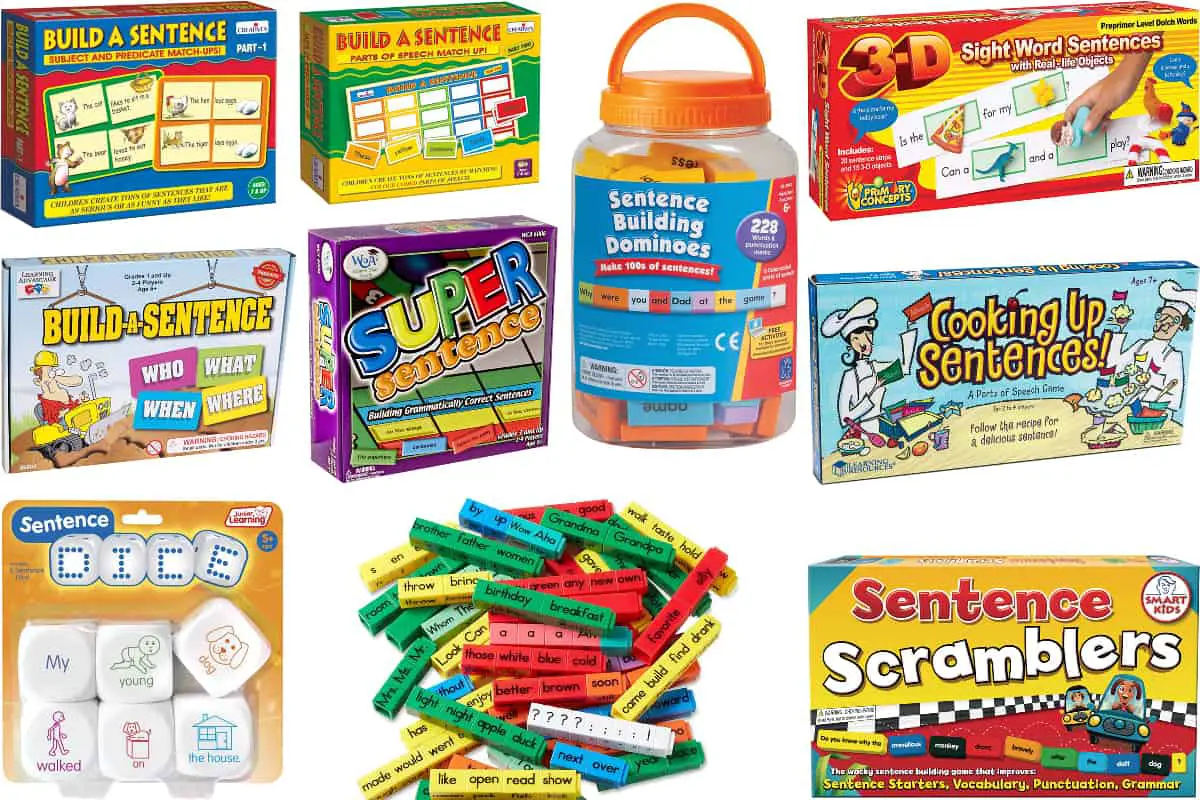This post contains affiliate links.
Children face multiple challenges with sentence construction. Board Games help teachers and parents face the challenge of getting children excited enough about mastering correct sentence construction.
I found 14 sentence building board games for children aged 6 to 13. Some use boards, and others dice, rods, dominoes, or other game parts. I highly recommend “Sentence Dice”, “Cooking Up Sentences”, “Sentence Building Rods” and “Super Sentence”.
Sentence Building Board Games Comparison Table
These 14 board games for sentence building help children of all ages master the ability to construct different types of sentences.
| Game | Age | Players | Price | For | Rating |
| Sentence Dice | 4-6 | 2 | $ | Families | ★★★★☆ |
| Build a Sentence Part 1 (Creative’s) | 5-6 | 2-4 | $$ | Families | ★★★☆☆ |
| Sentence Scramblers | 6-8 | 2-4 | $$$ | Teachers | ★★★☆☆ |
| 3-D Sight Word Sentences | 6-7 | 2-4 | $$$ | Families | ★★★☆☆ |
| Giant Sentence Building Cubes | 6-8 | 2-4 | $$$ | Teachers | ★★★☆☆ |
| Sentence Building Dominoes | 6-8 | 2-4 | $$ | Families | ★★★★☆ |
| Sentence Building rods | 6-10 | 2-4 | $$$ | Teachers | ★★★★★ |
| Build-A-Sentence (Learning Advantage) | 6‑8 | 2-4 | $$ | Families | ★★★☆☆ |
| 6 Grammar Games | 6‑8 | 2-4 | $$ | Teachers | ★★★☆☆ |
| Cooking Up Sentences | 7‑10 | 2-4 | $$$ | Teachers | ★★★★☆ |
| Build a Sentence Part 2 (Creative’s) | 8‑10 | 2 | $$ | Families | ★★★☆☆ |
| Sentence Scramble | 9-14 | 2-4 | $$ | Families | ★★★☆☆ |
| Super Sentence | 9‑14 | 2-4 | $$$ | Families | ★★★★☆ |
| Sentence Smart | 12‑13 | 2-4 | $$$$ | Teachers | ★★☆☆☆ |
Sentence Building Board Games for Primary School
Sentence Dice (Junior Learning)
★★★★☆

Players: 2 | Ages: 4-6 | CCSS Grade: K1 to K2 | Price $ | For Families
The “Sentence Dice” game comprises six dice appropriately decorated with words and pictures, each with a different color to differentiate each part of speech:
- Purple dice: prepositions (A, My, Their…), the first word of the sentence
- Green dice: adjectives (old, big, happy, young…)
- Orange dice: nouns (fish, dog…)
- Pink dice: past tense verbs (ate, swam, walked, sung…)
- Red dice: adverbs (inside, outside…)
- Blue dice: the object of the verb (“the river.”, “the road.”, “the house.”, “the park.”), which is also the last part of the sentence
Tossing these dice enables to build a simple grammatically correct sentence every time. It might not make sense, making the sentence funny. You can start with just 4 dice (My / fish / ate / the river.), or include the 6 dice (Their / happy / dog / walked / inside / the house.)
Young children love dice and the instant random sentences that are created – and they learn the basics of sentence construction. The extreme simplicity of the game means that anybody can use it.
Of course it is limited because there are only 6 dice. You can expand the game though by:
- Creating your own additional (alternative) dice using the same colors for each part of speech.
- Making the sentences a bit more complex by adding a few additional dice, and replacing the end dice, like in (Their / happy / dog / walked / quickly / inside / the green / house.).
Build a Sentence Part 1 (Creative’s)
★★★☆☆

Players: 2-4 | Ages: 5 – 6 | CCSS Grade: K2 – 2 | Price $ | For Families
The subject and predicate are the building blocks of sentence construction. Creative’s Part “Build a Sentence Part 1” helps children understand how to combine subjects and predicates to create sentences. Some of the sentences may be funny, others may be serious. The aim is to help children in grades K2 to two have fun learning how to combine simple subjects and predicates to create simple sentences.
Note that the sentences are always made with just two cards, making the game very simple to use but also quite limited. It contains 30 predicate cards and 30 subject cards, but you can create your own as the principle of the game is so simple!
You might also use the game to assess with the child if the sentence states something possible or impossible.
Sentence Scramblers (Smart Kids)
★★★★☆
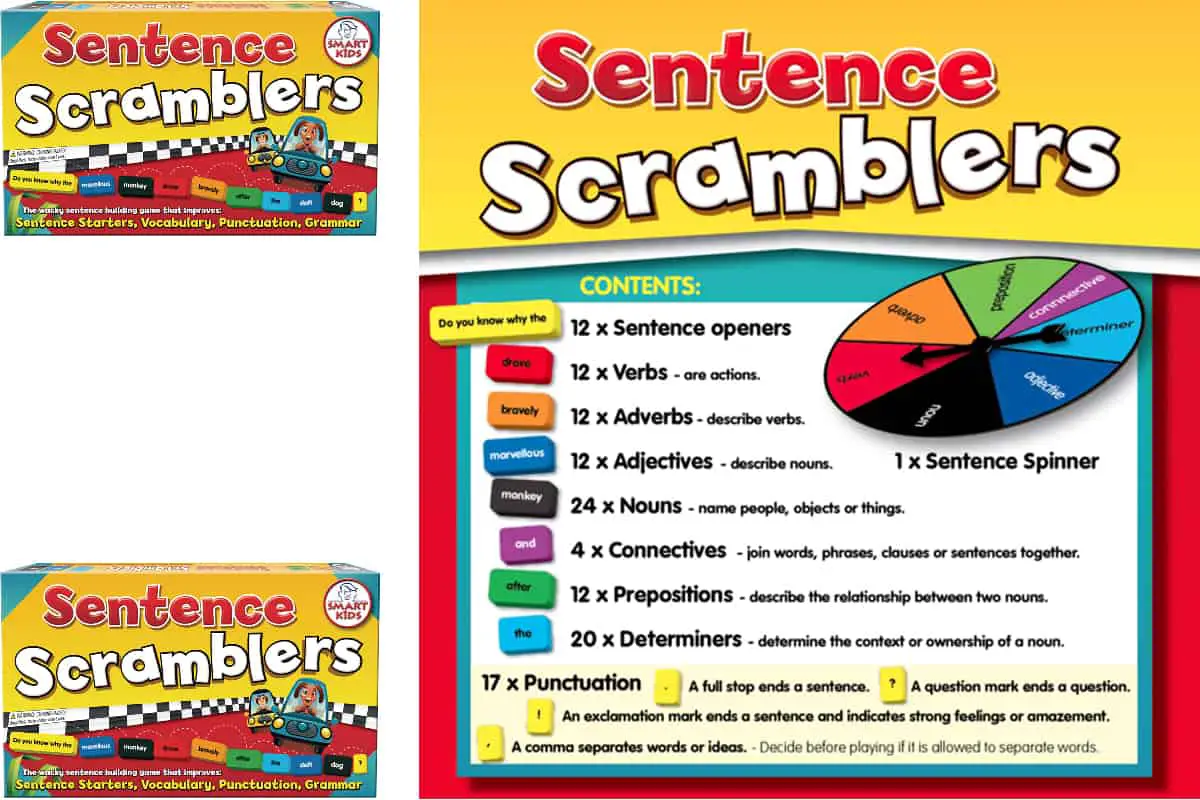
Players: 2-4 | Ages: 6-8 | CCSS Grade: 1-2 |Price $$$ | For Teachers
The purpose of Sentence Scramblers is two-fold:
is two-fold:
- Help students understand how to create simple and compound sentences with the right punctuation.
- Expands the vocabulary of students in grades one and two who may not have been exposed to words such as marvelous.
These two purposes make Sentence Scramblers ideal for more advanced students in grades one and two.
The game includes a “parts of speech” spinner, and 125 foam tiles that are color-coded by parts of speech:
- 12 sentence openers
- 12 verbs
- 12 adverbs
- 12 adjectives
- 24 nouns
- 4 connectives
- 12 prepositions
- 20 determiners
- 17 punctuations
The rule consists of building complete sentences that players try to add new words to as the game progresses (still keeping their sentences complete). this is a very interesting (and pedagogically effective) rule as the task gets progressively more difficult, which does not discourage players at the beginning but maintains a constant challenge.
The game parts are also very generic, which enables you to use the game with your own rules. For example, you can easily ask students to build sentences according to predefined sentence structures. You can also ask them to replace sentence elements in existing sentences to attain certain goals (for example making a sentence funnier, of making the sentence something possible or impossible).
3-D Sight Word Sentences (Primary Concepts)
★★★☆☆
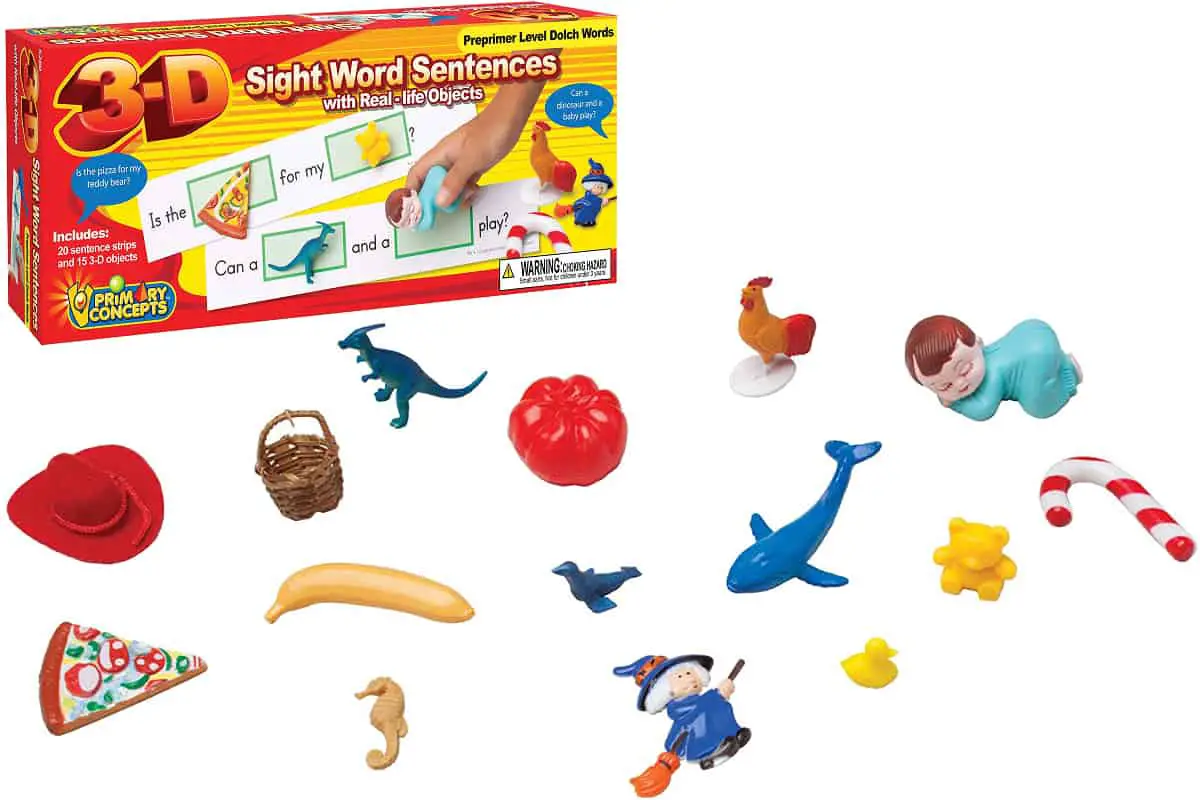
Players: 2-4 | Ages: 6-7 | CCSS Grade: 1-2 | Price $$$ | For Families
3-D Sight Word Sentences is designed to meet the needs of both visual and tactile learners, a feature that makes it ideal for children in grades one and two. Children fill in missing areas of sentence cards with 3-D sight words. Therefore, the game is good for improving sentence building skills, and for helping children associate nouns with their physical counterparts. Primary Concepts calls these words “sight words”.
is designed to meet the needs of both visual and tactile learners, a feature that makes it ideal for children in grades one and two. Children fill in missing areas of sentence cards with 3-D sight words. Therefore, the game is good for improving sentence building skills, and for helping children associate nouns with their physical counterparts. Primary Concepts calls these words “sight words”.
The main drawback of this game, however, is that the sentence cards and real-life word replicas are limited. There are only 20 sentence cards and 15 real-life replicas. Although the focus is on fundamental words that children in grades one and two should learn, it would have been great to expand the word repository so that more advanced students could have an appropriate challenge.
Giant Sentence Building Cubes (Lakeshore)
★★★☆☆
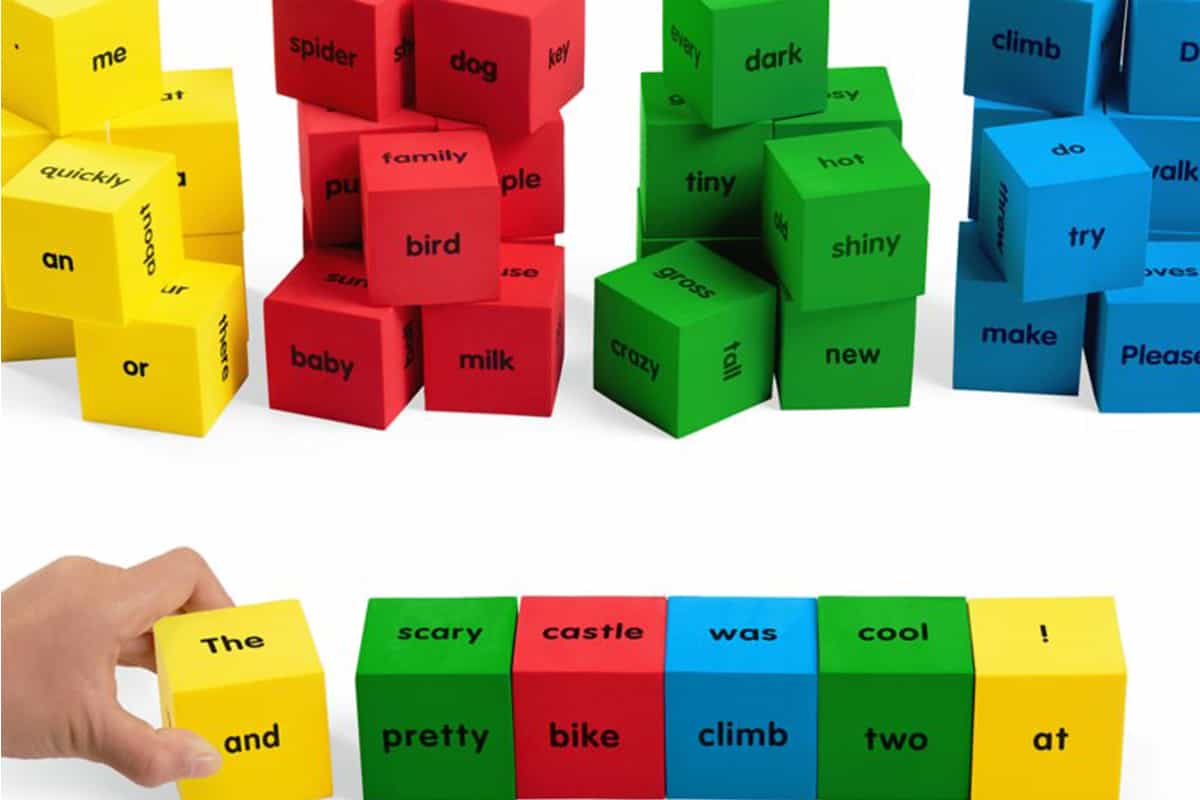
Players: 2-4 | Ages: 6-8 | CCSS Grade: 1-3 | Price $$$ | For Teachers
These sentence building cubes are fun and can be used in so many ways that I had to include it in this list. Players will have fun seeing the crazy sentences they create through the random roll of the dice. The game is simple to understand – players roll six dice (one of each color, featuring each a part of speech) and rearrange them to make grammatically correct sentences. If a sentence can’t be created, the player loses the turn.
are fun and can be used in so many ways that I had to include it in this list. Players will have fun seeing the crazy sentences they create through the random roll of the dice. The game is simple to understand – players roll six dice (one of each color, featuring each a part of speech) and rearrange them to make grammatically correct sentences. If a sentence can’t be created, the player loses the turn.
The 40 cubes (240 faces) are made of foam, which is less sturdy than plastic:
- 9 red nouns dice (54 nouns)
- 9 green adjectives dice (54 adjectives)
- 9 blue verbs dice (54 verbs)
- 13 diverse parts of speech and punctuation yellow dice (78 faces)
Sentence Building Dominoes (Educational Insights)
★★★★☆
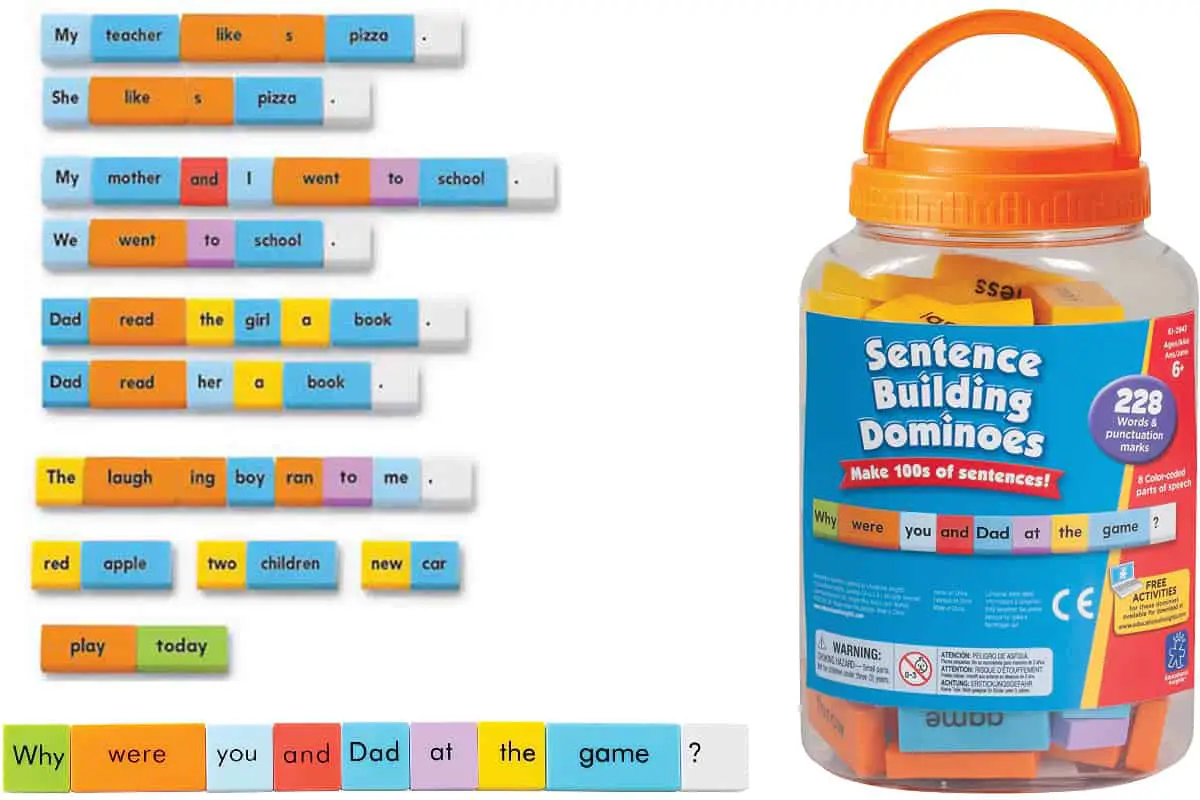
Players: 2-4 | Ages: 6-8 | CCSS Grade: 1-3 | Price $$ | For Families
Tactile learners are most likely to enjoy this sentence building dominoes game . The 114 double-sided dice include 228 nouns, pronouns, verbs, adjectives, adverbs, prepositions, conjunctions, and punctuation marks (color-codes for 8 parts of speech). This makes the game adaptable to suit the needs of students at various learning levels. The game’s activity guide helps teachers and parents understand how to adapt the game for these purposes.
. The 114 double-sided dice include 228 nouns, pronouns, verbs, adjectives, adverbs, prepositions, conjunctions, and punctuation marks (color-codes for 8 parts of speech). This makes the game adaptable to suit the needs of students at various learning levels. The game’s activity guide helps teachers and parents understand how to adapt the game for these purposes.
The dominoes are sturdy as they are made of hard plastic. And the pieces are smaller than the foam cubes of “Giant Sentence Building Cubes” by Lakeshore, which makes the game easier to use on small tables. You can also introduce a bit of grammar with the plural and building verbs from nouns (laugh ==> laugh / ing), which is great.
My only regret is that commas are missing.
Sentence Rods (Hand2Mind)
★★★★★
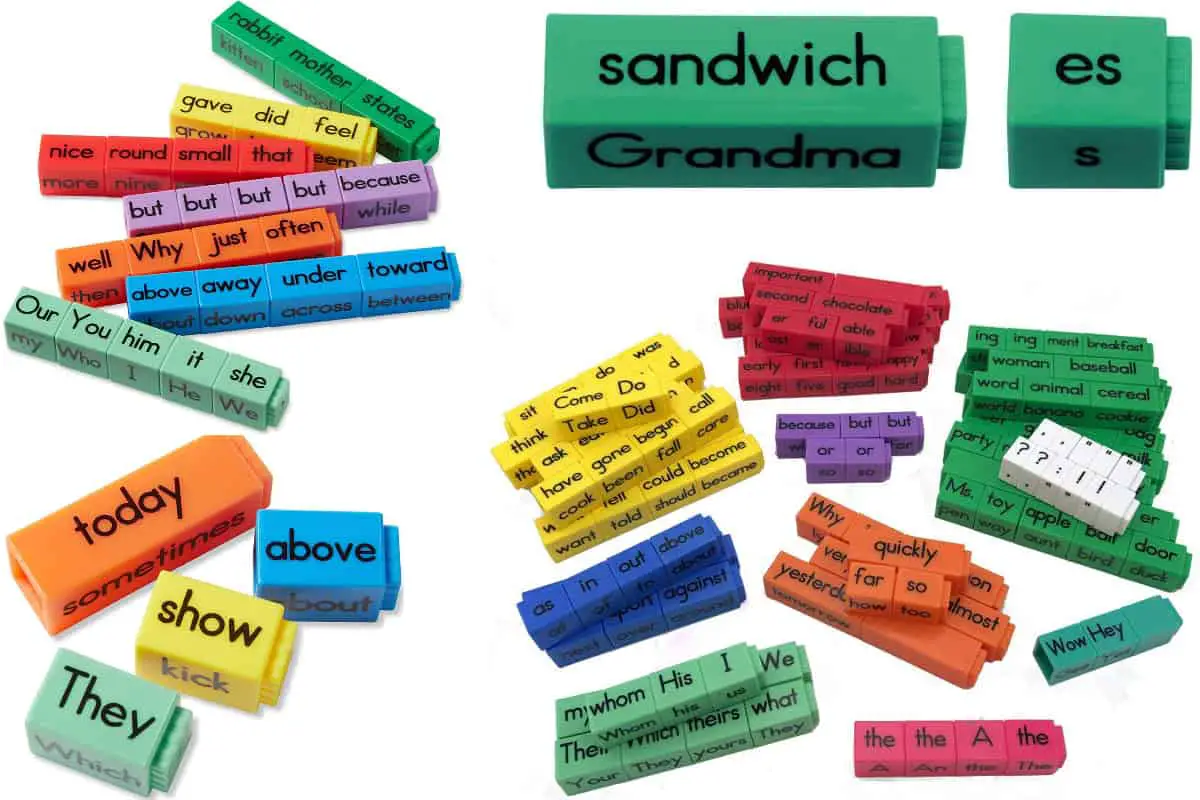
Players: 2-4 | Ages: 6-10 | CCSS Grade: 1-3 | Price $$$ | For Teachers
The Hand2Mind Sentence Rods function in a manner similar to the Sentence Building Dominoes.
function in a manner similar to the Sentence Building Dominoes.
But is way richer, making it a more attractive option, especially for teachers:
- The game has almost 3 times more words because there are more pieces, and the pieces are rods. They can be rotated on their 4 different faces to create the sentences, while dominoes have only two faces. So the 158 rods offer 632 possibilities while the 114 dominoes only 228.
- Some of the rods have blank spaces where appropriate words can be written using a dry-erase marker.
- The rods stick when connected, which is a great advantage if you want to build sentence parts that you will combine together.
- You have much richer punctuations marks including semicolons, commas, quotation marks
The only problem is that rods can sometimes difficult to pull apart. This is not much of a problem usually except for the small punctuation rods.
Build-A-Sentence (Learning Advantage)
★★★☆☆
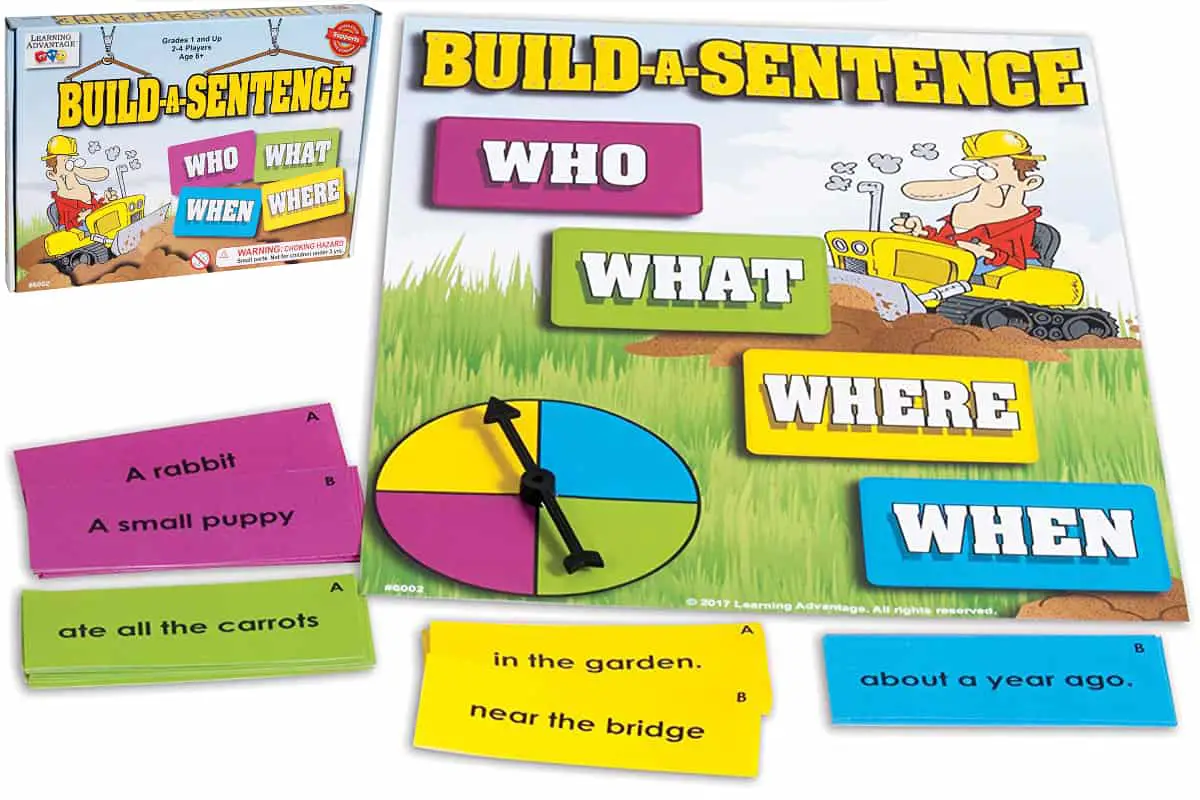
Players: 2-4 | Ages: 6-8 | CCSS Grade: 1-3 | Price $$ | For Families
The imagery and simplicity of Learning Advantage’s Build-A-Sentence game make it ideal for young children in grades one to three. It’s also an ideal game for teaching the basics of sentence construction. Players spin the spinner, pick a phrase card with the corresponding color and then put a sentence together after a few turns. There are 140 phrase cards split across four categories (who, what, where and when).
make it ideal for young children in grades one to three. It’s also an ideal game for teaching the basics of sentence construction. Players spin the spinner, pick a phrase card with the corresponding color and then put a sentence together after a few turns. There are 140 phrase cards split across four categories (who, what, where and when).
The words and phrases are simple enough for children in grades one to three. This positive feature of the game makes it particularly useful for improving sentence structure and reading skills.
Six Grammar Games (Junior Learning)
★★★☆☆
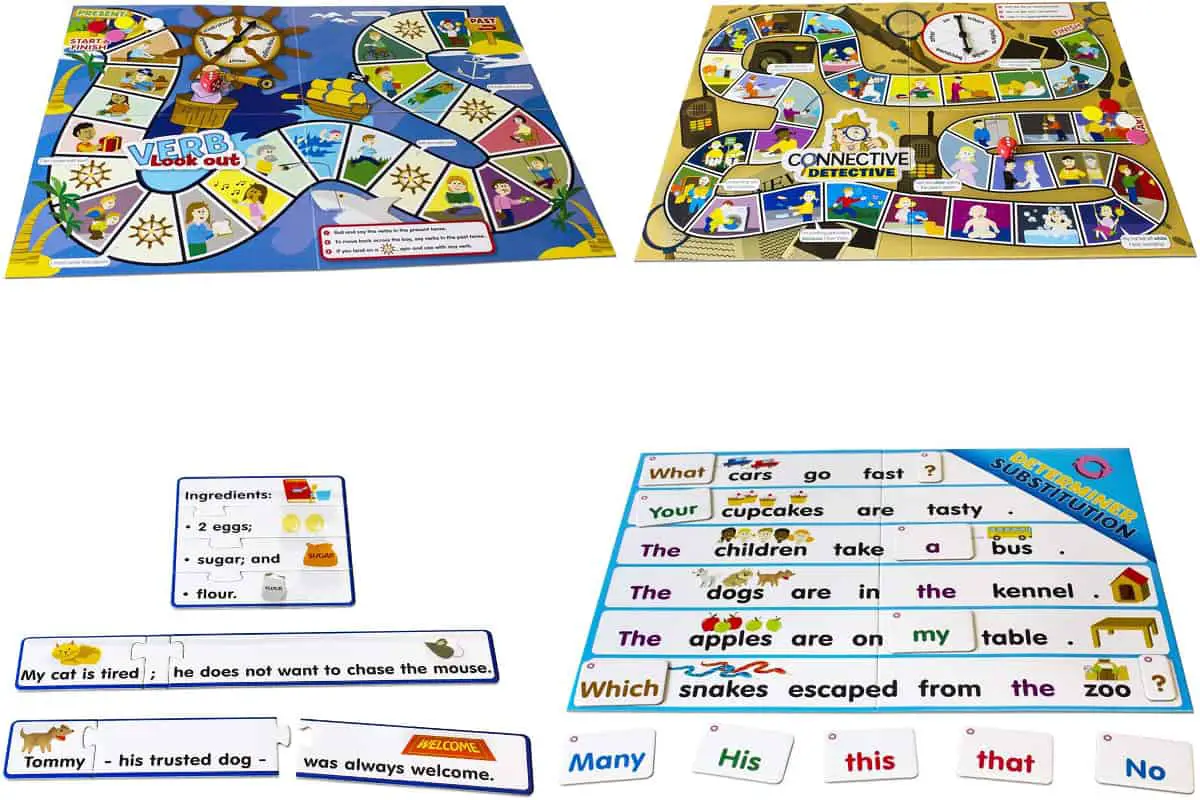
Players: 2-4 | Ages: 6-8 | CCSS Grade: 2-4 | Price $$ | For Teachers
This collection of grammar games can be an addition to a teacher’s English classroom learning center. There are two board games, two matching games, and 14 sentence puzzles. They teach punctuation, sentences, connectives, modal verbs, tenses determiners, phrases, and adverbials.
of grammar games can be an addition to a teacher’s English classroom learning center. There are two board games, two matching games, and 14 sentence puzzles. They teach punctuation, sentences, connectives, modal verbs, tenses determiners, phrases, and adverbials.
You should note that the games require only a pretty basic level of understanding of sentence structures though.
Cooking Up Sentences (Learning Resources)
★★★★☆

Players: 2-4 | Ages: 7-9 | CCSS Grade: 2-4 | Price $$$ | For Teachers
Vibrant colors and an eye-catching design make this parts of speech game enticing for young children in grades two to four.
enticing for young children in grades two to four.
The game includes:
- 4 double-sided Recipe cards that list ingredients that are parts of speech and must be used in a sentence.
- 150 small white parts of speech tiles (color-coded on the back, with 8 types: noun, verb, adjective, pronoun, conjunction, preposition, articles, adverb)
- Free ingredient cards, pans, spinner
The cooking theme is relevant to the sentence building objective. The game is based on collecting ingredients (parts of speech) to make a complete recipe (sentence). Teachers can adapt the game to suit students at different levels.
Build a Sentence Part 2 (Creative’s)
★★★☆☆
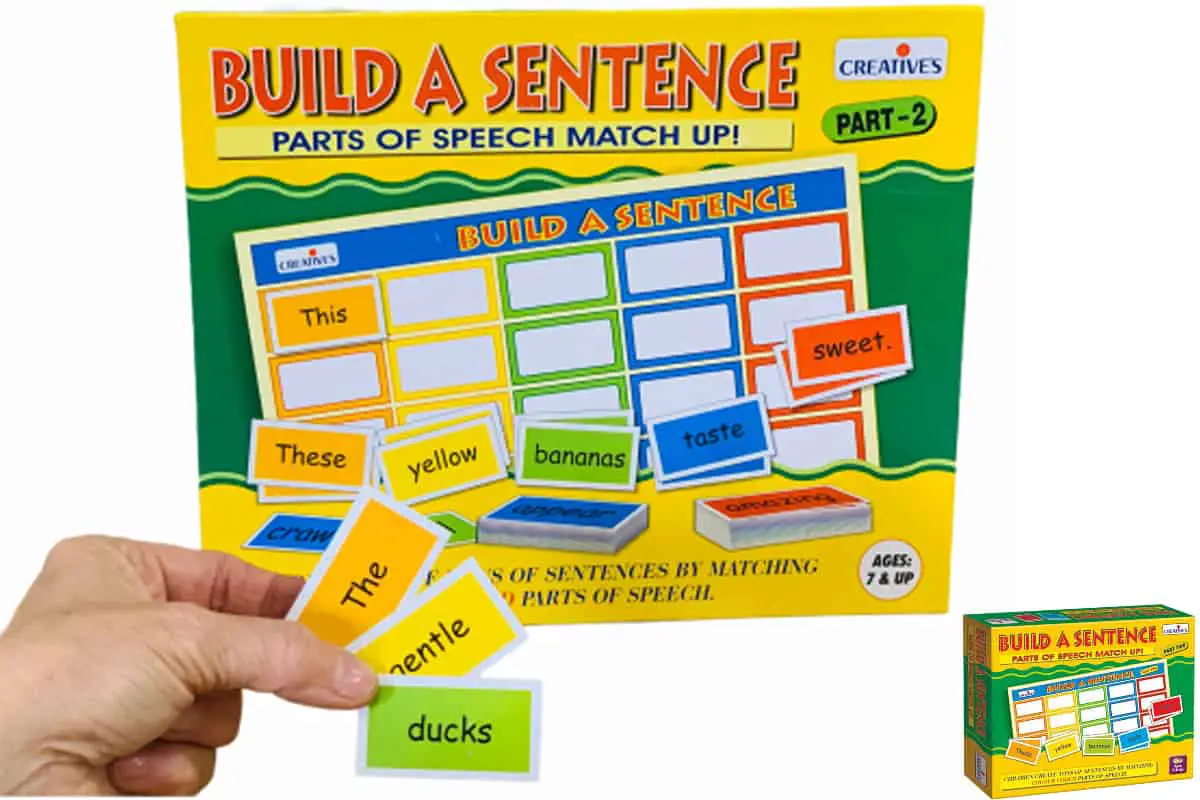
2 players | Ages: 8-9 | CCSS Grade: 3-4 | Price $$ | For Families
The Creative’s Part-2 “Build a sentence” game provides a second step on the logical progression for learning parts of sentences and how to effectively combine them. Part two pays specific attention to the important role of parts of speech in a sentence. Each player is given a blank game board that is color-coded to match the various parts of speech. 240 parts of speech cards enable the players to build their sentences.
pays specific attention to the important role of parts of speech in a sentence. Each player is given a blank game board that is color-coded to match the various parts of speech. 240 parts of speech cards enable the players to build their sentences.
The aim is to create as many grammatically correct sentences as possible.
However there are only 5 parts of speech to use (start of sentence, nouns, verbs, adverbs, adjectives), the sentence structures are really limited and the cards are not of very good quality.
Sentence Scramble (Wiebe Carlson Associates)
★★★☆☆

Players: 2-4 | Ages: 7-9 (or 9-12 for ESL) | CCSS Grade: 4-8 | Price $$ | For Families
English as a Second Language (ESL) teachers will find Sentence Scramble useful for building these students’ basic language skills. It follows a premise similar to Scrabble except that players are building sentences rather than words. Players have to carefully choose common English words to create grammatically correct sentences in the form of a crossword puzzle.
useful for building these students’ basic language skills. It follows a premise similar to Scrabble except that players are building sentences rather than words. Players have to carefully choose common English words to create grammatically correct sentences in the form of a crossword puzzle.
What would kick this game up a notch is if it included advanced words for advanced players. These words would help more advanced students expand their vocabularies while also helping them understand how to use these new words in sentences.
Sentence Building Board Games for Middle School and Up
Super Sentence (Learning Advantage)
★★★★☆
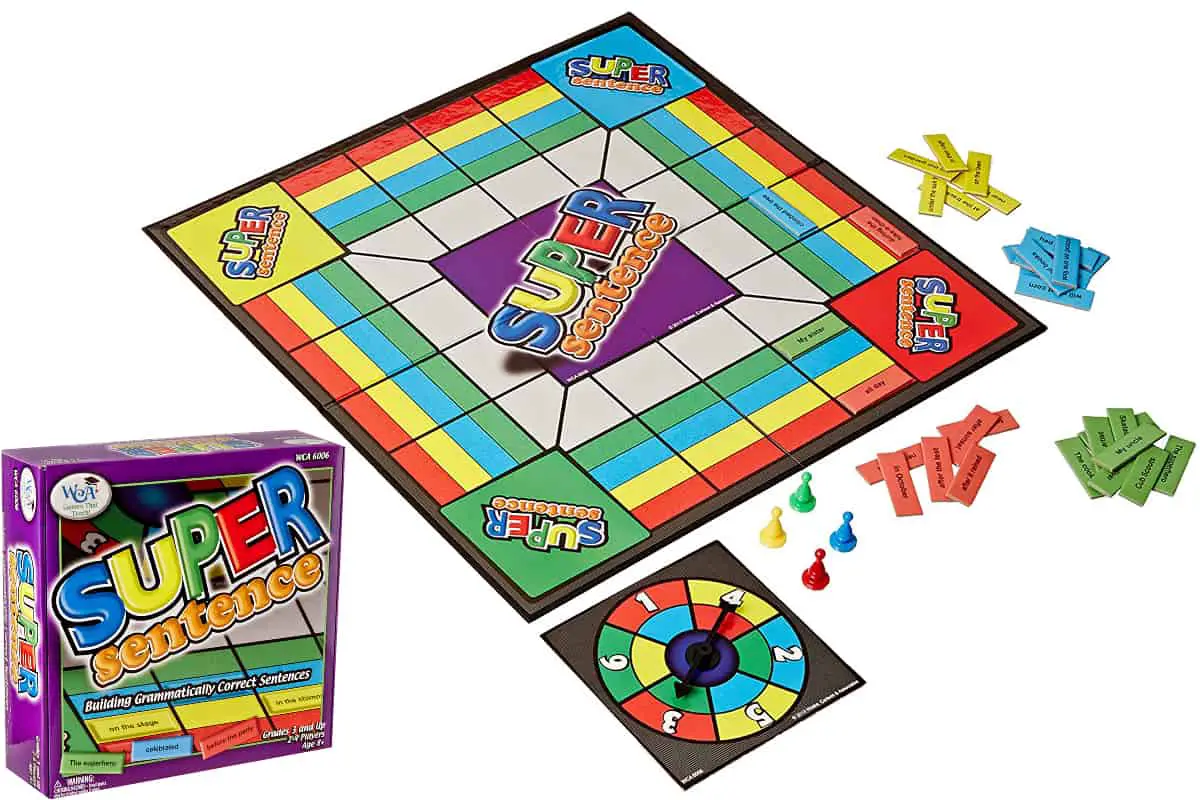
Players: 2-4 | Ages: 9-14 | CCSS Grade: 4-9 | Price $$$ | For Families
The “Super Sentence” Game by Learning Advantage is a strategy game that brings players into a world of grammatically correct sentences. The first player to correctly complete five sentences wins. Some of the sentences will be silly (that’s the fun of the game after all) but they should be in the correct tense, use verbs that agree, and the correct subjects.
There are four types of word tiles: who (green), what (blue), where (yellow) and when (red) tiles. Since the game is appropriate for a wide age group, teachers and parents can choose the best tiles based on the players’ English level. For instance, grade four students will most likely only use the where and when tiles. However, students in grades seven, eight and nine will most likely use all four categories of tiles.
This game is as much a game of strategy as it is a game of knowing how to put words together. Players may choose not to place tiles on a given turn based on how they think their opponents may capitalize on the placements. They can also make this decision while trying to choose the best combination of tiles to make a grammatically correct sentence. Players can challenge the construction of sentences created by their opponents. Successful challenges result in the tiles being returned to the unclaimed tiles piles. However, unsuccessful challenges result in the opponent having to surrender any sentences created. This is where the competition intensifies!
The sentence tiles are made of sturdy material. The length of the game and the competitiveness make the game more interesting at home in my opinion.
Sentence Smart Board Game (Scholar Skills)
★★☆☆☆

Players: 2-4 | Ages: 12-13 | CCSS Grade: 7| Price $$$$ | For Teachers
Scholar Skills’ Sentence Smart Board Game has a board with color-coded spaces for each part of a sentence. The aim of the game is to be the first player to get rid of all their word cards by constructing a complete sentence with them.
has a board with color-coded spaces for each part of a sentence. The aim of the game is to be the first player to get rid of all their word cards by constructing a complete sentence with them.
The board is attractive, with several bonus sections, such as a spinner and white cards, to increase the excitement and competition within the game. Cards are also color-coded (green- nouns and pronouns, yellow – verbs, blue- adverbs, red – adjectives, purple – prepositions and orange – conjunctions) so players can easily identify the parts of the sentence.
My concern is that only one player gets to build a full sentence and win. It would have been better to build a mechanism where all players would generate several sentences, such as with “Super Sentence” for example.
Edudingo.com is a participant in the Amazon Services LLC Associates Program, an affiliate advertising program designed to provide a means for sites to earn advertising fees by advertising and linking to Amazon.com. We also participate in other affiliate programs which compensate us for referring traffic.

